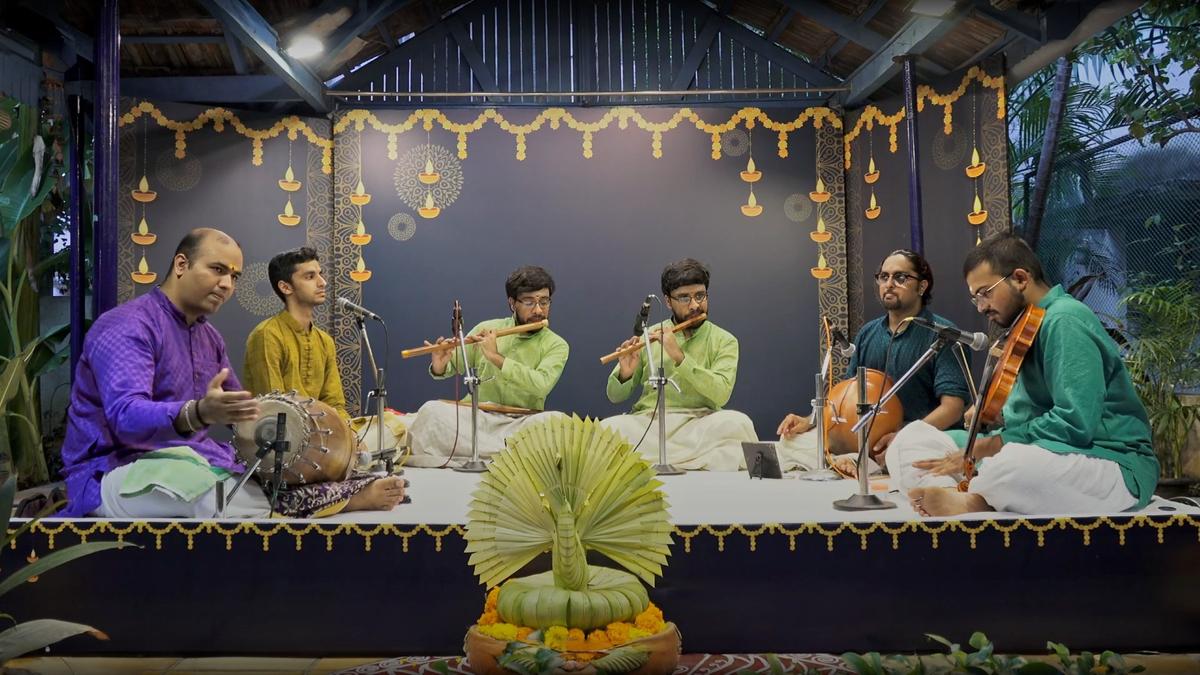
Herambh and Hemanth with Vinay Varanasi, Sayee Rakshith, B.S. Prashanth and Chandrasekara Sharma.
| Photo Credit: Courtesy: MadRasana
A Sankarabharanam package that the twin brothers, Heramb and Hemanth, unfolded in the second half of their concert bore elements of universal appeal that befitted the unusual theme: birds in Carnatic music. The third in MadRasana’s five-part ‘Prakriti’ series showcased how winged creatures enhance the aural aesthetics beyond their appearances in the lyrics.
Syama Sastri’s ‘Sarojadala netri’ was the centrepiece by the Bengaluru-based flautists , coming after a detailed alapana of purist’s delight and tanam high on eclecticism. As artistic director Vinay Varanasi said, the kriti extolling Meenakshi carries not one but two references to divine parrots — shukapaani and shukashyamala.
Yet the overall presentation was not literature-driven. The wind instrument anyway produces only notes, and Heramb took off from the anupallavi (that mentions shukapaani). In fact, the siblings wound up the composition in just three minutes and coasted on to swaraprastara. Violinist Sayee Rakshit toed the serene beauty of the flautists, who soon went for a change of ragas. Hamsanandi (by Heramb), Hamsanadam (Hemanth) and Hamsadhwani (Sayee) lit the line-up. Their tonal quality alone should have appealed, but the listener was reminded that ‘Hamsa’ implied the floating swan.
Interesting grahabhedam
The twins then resorted to an interesting grahabhedam, revealing that the pivotal ‘sa’ and ‘pa’ of Sankarabharanam are prakriti swaras, believed to have derived from the peacock and cuckoo respectively. And when Heramb explained how certain shifts in the tonic tones would lead to ragas such as Kharaharapriya, Thodi and Kalyani, his brother kept the rhythmic flow intact by tapping the two-kalai Adi on his lap. Soon, Sankarabharanam returned and a crisp kanakku capped the solfa sequence. The 12-minute tani avartanam between B.S. Prashanth (mridangam) and Chandrasekhara Sharma (ghatam) was seamless with stress on resonance and cadence than arithmetic complexities.
Earlier, the alapana of Sankarabharanam sounded largely conventional, but the duo’s explanation made the phrases sound all the more sonorous. Together the brothers, sketched the raga for 18 minutes, and the violinist’s reply was equally proportionate. The tanam saw the flautists bringing in a western touch, to which Sayee’s response was apt. Sankarabharanam, pertinently, is a major scale across continents and the concept of Nature in this case should not restrict just to the Deccan.
Raga in a bird’s name
The 135-minute kutcheri on the stage, decked with potted plants and leafy artworks, began with a raga that carried a bird’s name: Mayuradhwani. Tyagaraja’s ‘Ragasudharasa’ was delivered well, with a flutter of notes towards the end of the pallavi effectively symbolising the peacock dance. The subsequent swaras wore a kaleidoscopic quality even as they conjured up a range of patterns. Yet the compere in the all-young team could have clarified that Mayuradhwani is popularly called Andolika in modern times.
Anandabhairavi, with its oscillations, came as the second raga when ‘Marivere gati’ was rendered. It substantiated a preamble that highlighted the kriti’s association with the goddess at Kanchipuram and the famed buzz of the parakeets in its precincts. The graceful unevenness of Misra Chapu tala added to the leisure of the Syama Sastri kriti.
The gentle touch of the feathers of Vishnu’s carrier formed the subject of the third piece. Tyagaraja’s ‘Gnanamosaga rada’ follows with the words ‘Garuda gamana’ or the gait of the giant eagle. Its meditative spirit, as mentioned in Dhruva Charitam, came through in the unhurried alapana, but the kriti was reasonably pacy. The swansong was Annamacharya’s ‘Narayana te’ in Behag. Prudently, it also attempted a throwback to the themes of the first two concerts in the Prakriti series: mountains (nagadhara: hill-lifting Krishna) and flowers (pankachanabha: the lord with lotus from his navel).





